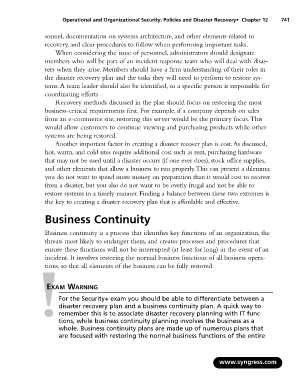Page 757 - StudyBook.pdf
P. 757
Operational and Organizational Security: Policies and Disaster Recovery• Chapter 12 741
sonnel, documentation on systems architecture, and other elements related to
recovery, and clear procedures to follow when performing important tasks.
When considering the issue of personnel, administrators should designate
members who will be part of an incident response team who will deal with disas-
ters when they arise. Members should have a firm understanding of their roles in
the disaster recovery plan and the tasks they will need to perform to restore sys-
tems.A team leader should also be identified, so a specific person is responsible for
coordinating efforts.
Recovery methods discussed in the plan should focus on restoring the most
business-critical requirements first. For example, if a company depends on sales
from an e-commerce site, restoring this server would be the primary focus.This
would allow customers to continue viewing and purchasing products while other
systems are being restored.
Another important factor in creating a disaster recover plan is cost.As discussed,
hot, warm, and cold sites require additional cost such as rent, purchasing hardware
that may not be used until a disaster occurs (if one ever does), stock office supplies,
and other elements that allow a business to run properly.This can present a dilemma;
you do not want to spend more money on preparation than it would cost to recover
from a disaster, but you also do not want to be overly frugal and not be able to
restore systems in a timely manner. Finding a balance between these two extremes is
the key to creating a disaster recovery plan that is affordable and effective.
Business Continuity
Business continuity is a process that identifies key functions of an organization, the
threats most likely to endanger them, and creates processes and procedures that
ensure these functions will not be interrupted (at least for long) in the event of an
incident. It involves restoring the normal business functions of all business opera-
tions, so that all elements of the business can be fully restored.
EXAM WARNING
For the Security+ exam you should be able to differentiate between a
disaster recovery plan and a business continuity plan. A quick way to
remember this is to associate disaster recovery planning with IT func-
tions, while business continuity planning involves the business as a
whole. Business continuity plans are made up of numerous plans that
are focused with restoring the normal business functions of the entire
www.syngress.com

